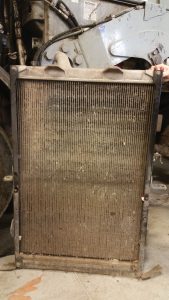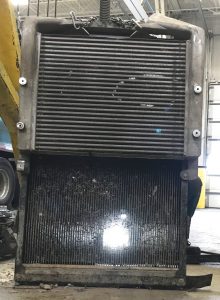By replacing today’s large single mechanical fan with a series of smaller electric fans, this new electric cooling approach accounts for fuel economy improvements upwards of 18 percent, thereby lowering emissions.
Reducing operating costs, increasing uptime and reducing emissions remain critical challenges to solid waste haulers across the industry. Refuse fleets are continuously adopting new technology to achieve this, exemplified by the recent shift toward CNG and hybrid powertrains. Today, there is a new emerging technology in the solid waste industry—a fully electric engine cooling system. Since transforming the transit bus industry over the last decade (with 22,000 in operation), these systems continue to demonstrate better fuel economy and reduced maintenance among other benefits. In fact, in every major bus system in the U.S., along with cities in Canada and Mexico, the electric cooling system is set to be the new face of cooling in the refuse industry.
By minimizing parasitic loss through replacing today’s large single mechanical fan with a series of smaller electric fans, this new electric cooling approach accounts for fuel economy improvements upwards of 18 percent, thereby lowering emissions. Patented software systems control the fans for more efficient, optimized cooling. The most significant benefit, however, is the reduced maintenance on the radiator package through the fully reversible fans, increasing uptime and significantly saving on costs.
A single large mechanical fan is a slave to engine speed, and can consume as much as 40 horsepower from the engine using outdated technology. Drivers are familiar with the sensation of an engaging mechanical fan; there is an audible feedback, but even more noticeable is a sensation of the engine being bogged down by the added load. In contrast, the use of electric fans allow for fan reversal, which keep the heat exchangers clean while cooling with much lower power needed than the mechanical fan. In a normal pickup situation, even in high ambient temperatures, the electric fan system will only draw a maximum of about 5 horsepower from the engine. This significant savings improves fuel economy, and, in turn, reduces emissions while improving vehicle performance.
Electric Fan System Dramatically Outperforms Mechanical Single Fan
EMP Corporation (Escanaba, MI) performed a recent set of studies with their Mini-Hybrid® system to determine how the electric fan approach can work within the refuse industry. The Mini-Hybrid® system was the first of its kind in the world of engine cooling systems when it was first introduced to the transit market in 2006. Since then, EMP has been able to improve on both its fan and software technology. The Mini-Hybrid® system consists of an array of five to six electric fans—either 11inch, 15inch, or a combination of the two—mounted to a shroud that can be attached to a refuse vehicle’s existing radiator. The fans use long life brushless, DC motors with variable fan speed control and full reversibility. The fans are controlled by a thermal management controller (TMC) that communicates via CAN (J1939) to the engine and transmission. EMP’s patented shroud baffles enable application of this strategy by isolating the air flow of each fan from the rest, allowing for precisely directed air flow to the radiator, AC condenser and charge air cooler.
Refuse vehicles have a unique set of challenges that the transit industry simply does not. Residential waste vehicles have an extremely harsh duty cycle with frequent stop-and-go, along with high engine load at low speed. The excessive amount of debris encountered during pickup and at the landfill also causes chronic plugging of the heat exchangers.
Field Test #1
One partner property was Advanced Disposal located in Muskego, WI. There, EMP was offered a 2013 Mack MRU-613 with an MP7-325Hp engine, as well as a 2012 Autocar Xpeditor with an ISL-G 320Hp engine for testing. The ongoing test produced significant results consistent with the other testing properties.
This particular Mack visits the landfill two times daily and often gets stuck when the ground is wet and soft. This requires a tow to release it from the mud. In the process, the skid plate under the vehicle acts as a shovel and will pack dirt into the radiator and fans. By using the reversible E-fan system, the radiators were able to stay clean throughout the year even with these harsh conditions (see Figures 1 and 2). A cleaner radiator results in a far more efficient heat exchanger package, enabling superior engine cooling. The benefits of this can also be seen through increased longevity in accessories and components tied directly to the engine. When used on a daily basis, the reversible fans kept the dust and debris from this residential route out of the radiator. Preventative maintenance on the radiator was virtually eliminated.


Throughout this testing, the Mack MRU-613 was able to increase fuel efficiency by 7.7 percent through parasitic load reduction and maintaining a clean radiator. This produced an average savings of 55.5 gallons of fuel per month resulting in an estimated fuel savings of nearly $1,800 per year (based on a five-year national average diesel price of $2.71/gal). The data from testing also showed the electric fan system drew less than 2.5 horsepower from the engine during 95 percent of vehicle’s operation.
Field Test #2
Advanced Disposal’s second truck, the Autocar with an ISL-Gas engine, saw similar results in fuel savings as the Mack. The Autocar was tasked with a residential route that also sent it to the landfill twice daily, but came with a different challenge. This landfill contained “Auto Fluff”, a landfill cover that consists of ground up automotive interiors such as dashes and seats. The “Fluff” has been continually problematic, clogging radiators causing overheating issues and extensive maintenance. Over the last six months of testing, the radiator on the Autocar has remained debris free thanks to daily fan reversal.
Controlled Study
In addition to field testing with Advanced Disposal, EMP also conducted a closed course fuel efficiency study with the City of Green Bay at Fox Valley Technical College’s J.J. Keller Transportation Center. Two identical 2013 Peterbilt 320’s with ISL-D 380 horsepower engines were used in the testing. One was with a control truck equipped with an OEM mechanical fan and the other with the Mini-Hybrid® system. This test simulated a residential 40-can pick up with identical routes between the two vehicles. The engine data showed an 18.5 percent improvement in favor of the electric fan system for fuel consumption. The majority of savings was concluded to be from the Mini-Hybrid’s efficiency during slow moving or stationary operation, when fan demand is at its highest and engine speed is at its lowest.
The ‘Smart’ Difference in Technology
The cornerstone of EMP’s Mini-Hybrid® system technology is the patented software applications, EMPredict™ and EMPrecision™, which were developed specifically for the system’s application. EMPredict™ monitors engine power in real-time in order to anticipate cooling demands before they are needed. This reduces the response time of cooling fan fluctuations during duty cycles, resulting in optimal running temperatures. This is especially beneficial in refuse applications involving frequent stop-and-go operation. Mechanical fans simply cannot respond fast enough to keep up with cooling demands, resulting in wild coolant temperature fluctuations and thermal cycling that can reduce engine life. Because EMPredict™ maintains nearly constant coolant temperatures, it improves engine performance while reducing engine wear due to thermal cycling.
Once EMPredict™ anticipates a need for engine cooling, EMPrecision™ is used to apply the cooling. This piece takes advantage of the variable speed fans and baffles by directing them to provide the exact cooling when and where it is needed during a cycle. Even specific components can be cooled by the fans covering them. This smart system can be controlled to maintain tight engine temperatures while decreasing parasitic loss. And, because the electric fan system is not reliant on an engine drive, maximum cooling can be achieved during low vehicle or engine speeds.
The testing does not end with the studies above. EMP has also partnered with several different refuse properties throughout the U.S. to prove out the concept for a wide variety of situations. The vehicles chosen covered a wide range of manufacturers and climates, including the Mack MR688S, Peterbilt 320, and Autocar Xpeditor among others. These additional testing properties are located in Miami-Dade County, FL, Iron Mountain, MI, Charlotte, NC, DeKalb County, GA and Albuquerque, NM.
Across all models and climates, the Mini-Hybrid™ System results were remarkable, with an average fuel economy improvement of 8.1+ percent (Up to 18.3 percent). Coolant temperature was maintained within +/- 3° Celsius of the optimal running temperature for each engine. While these performance numbers are astounding, it is the uptime improvements created by the reversible multi-fan system that garnered the most attention. The electric Mini-Hybrid® system is quickly being accepted by the solid waste industry to revolutionize efficiency and uptimes.
During a recent regular follow up with Advanced Disposal, the EMP team wanted to check in on how the system was operating and verify any potential needs they had. When asked how much downtime the vehicles have had related to engine cooling, the response speaks for itself. According to B. Schlomann, Maintenance Manager at Advanced Disposal, “There has been zero downtime related to our cooling system. It has saved us a lot of headaches, time and money.”
EMP is a leader in complex precision machining and advanced thermal and oil management technologies and has been manufacturing Mini-Hybrid Thermal Management Systems since 2006. Based in the USA, EMP’s advanced products are used globally by major diesel engine OEMs and hydraulics manufacturers. For more information, contact Todd Kangas at (906) 789-7497, e-mail [email protected] or visit www.emp-corp.com.
